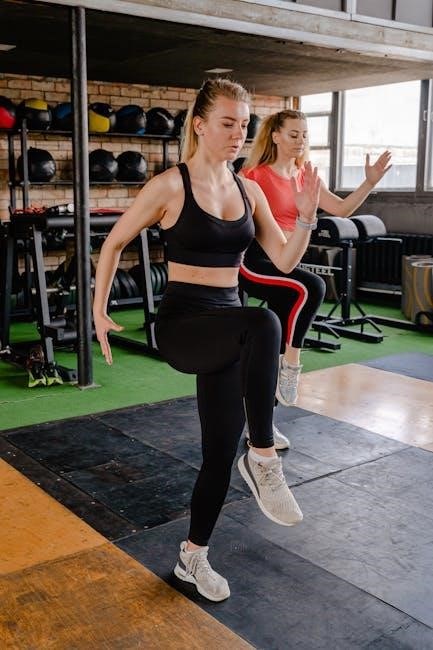full body kettlebell workout pdf
Crave a killer workout? Grab our FREE full body kettlebell workout PDF! Sculpt, shred, and sweat your way to a stronger you. Download now and feel the burn!
Full Body Kettlebell Workout PDF: An Overview
Looking for a comprehensive guide to full-body kettlebell workouts in PDF format? You’re in luck! Many resources offer printable training plans designed to build strength, burn fat, and improve overall fitness using kettlebells. These PDFs provide convenient access to effective routines.

Benefits of Full Body Kettlebell Workouts
Full body kettlebell workouts offer a multitude of benefits, making them a popular choice for individuals seeking efficient and effective training. One of the primary advantages is their ability to provide a comprehensive workout that targets multiple muscle groups simultaneously. Unlike isolation exercises that focus on a single muscle, kettlebell exercises engage numerous muscles in a coordinated manner, leading to greater overall strength and functional fitness. This makes them ideal for improving everyday movements and athletic performance.
Another significant benefit of full body kettlebell workouts is their ability to enhance cardiovascular fitness. The dynamic and compound nature of kettlebell exercises elevates the heart rate and increases oxygen consumption, providing a challenging cardio workout while simultaneously building strength. This dual benefit makes kettlebell workouts an excellent option for individuals looking to improve both their cardiovascular health and muscular strength.
Furthermore, full body kettlebell workouts can be highly effective for burning calories and promoting weight loss. The intense nature of these workouts, combined with the engagement of multiple muscle groups, leads to a significant calorie expenditure. Additionally, kettlebell exercises can help increase lean muscle mass, which further boosts metabolism and aids in weight management. The versatility of kettlebells allows for a wide variety of exercises that can be tailored to individual fitness levels and goals, making them a suitable option for both beginners and experienced athletes.
In addition to the physical benefits, full body kettlebell workouts can also improve coordination, balance, and stability. Many kettlebell exercises require a high degree of control and coordination, which helps to enhance proprioception and body awareness. This can lead to improved balance and stability, reducing the risk of falls and injuries. Moreover, kettlebell training can be a fun and engaging way to exercise, providing a refreshing alternative to traditional gym workouts. The variety of exercises and the challenge they present can help keep individuals motivated and committed to their fitness goals. Finally, kettlebell workouts can be performed virtually anywhere, making them a convenient option for those with busy schedules or limited access to gym facilities.

Essential Kettlebell Exercises for a Full Body Workout
To maximize the benefits of a full body kettlebell workout, it’s crucial to incorporate a range of exercises that target different muscle groups and movement patterns. Several key exercises stand out as essential for building strength, improving cardiovascular fitness, and enhancing overall functional fitness. The kettlebell swing is arguably the most iconic kettlebell exercise, and it’s a cornerstone of any full body routine. This dynamic movement engages the posterior chain, including the glutes, hamstrings, and lower back, while also improving cardiovascular endurance and power. Mastering the kettlebell swing is essential for building a solid foundation for more advanced kettlebell exercises.
Another fundamental exercise is the kettlebell deadlift, which strengthens the posterior chain and improves hip hinge mechanics. The kettlebell deadlift is a great starting point for beginners as it teaches proper form and builds a strong foundation for more complex movements. The goblet squat is another essential exercise that targets the lower body, particularly the quads, glutes, and core. Holding the kettlebell close to the chest promotes good posture and core engagement, making it an effective exercise for building lower body strength and stability.
For upper body strength, the kettlebell press is a must-include exercise. This exercise targets the shoulders, chest, and triceps, while also engaging the core for stability. The kettlebell row is another excellent upper body exercise that strengthens the back, biceps, and forearms. This exercise helps improve posture and balance out the muscles of the upper body. The Turkish get-up is a more advanced exercise that challenges the entire body, improving strength, stability, and coordination. This exercise requires a high degree of control and body awareness, making it a great test of overall fitness.
In addition to these essential exercises, there are many other kettlebell movements that can be incorporated into a full body workout, such as the clean, snatch, and windmill. These exercises offer a greater challenge and can help further improve strength, power, and coordination. By incorporating a variety of these essential kettlebell exercises into your routine, you can create a well-rounded full body workout that delivers a multitude of benefits.
Sample Full Body Kettlebell Workout Routines
Designing effective full body kettlebell workout routines requires careful consideration of exercise selection, rep ranges, sets, and rest periods. The goal is to create a balanced program that challenges all major muscle groups and improves both strength and cardiovascular fitness. Here are a few sample routines that can be adapted to different fitness levels and goals.
Beginner Full Body Kettlebell Workout: This routine focuses on mastering fundamental movements and building a solid foundation of strength and stability. It is ideal for individuals new to kettlebell training or those returning to exercise after a break. The workout includes: Kettlebell Swings (3 sets of 10-12 reps), Goblet Squats (3 sets of 8-10 reps), Kettlebell Deadlifts (3 sets of 8-10 reps), Kettlebell Rows (3 sets of 8-10 reps per side), and Kettlebell Presses (3 sets of 6-8 reps per side). Rest for 60-90 seconds between sets. This routine can be performed 2-3 times per week with at least one day of rest between workouts.
Intermediate Full Body Kettlebell Workout: This routine increases the intensity and complexity of the exercises, challenging both strength and cardiovascular fitness. It is suitable for individuals with some experience in kettlebell training. The workout includes: Kettlebell Clean and Press (3 sets of 6-8 reps per side), Kettlebell Snatch (3 sets of 5-7 reps per side), Kettlebell Turkish Get-Ups (2 sets of 1-2 reps per side), Kettlebell Front Squats (3 sets of 8-10 reps), and Kettlebell Renegade Rows (3 sets of 6-8 reps per side). Rest for 75-105 seconds between sets. This routine can be performed 2-3 times per week with adequate rest.
Advanced Full Body Kettlebell Workout: This routine pushes the limits of strength, power, and endurance. It is designed for experienced kettlebell practitioners who are looking for a challenging and effective workout. The workout includes: Kettlebell Long Cycle (Clean and Jerk) (3 sets of 5-7 reps per side), Kettlebell Windmills (3 sets of 3-5 reps per side), Kettlebell Bottoms-Up Squats (3 sets of 5-7 reps), Kettlebell Overhead Lunges (3 sets of 6-8 reps per side), and Kettlebell Complexes (3 sets of 3-5 reps). Rest for 90-120 seconds between sets. This routine can be performed 1-2 times per week, allowing for ample recovery.

Kettlebell Workout Program Structures
Structuring a kettlebell workout program involves organizing workouts to achieve specific fitness goals. Several approaches can be used, each with its own advantages. These include full body focus, push/pull/legs split, and upper/lower split routines, each offering a distinct way to train.
Full Body Focus
A full body focus in kettlebell training involves working all major muscle groups in each workout session. This approach is excellent for those with limited time, as it maximizes efficiency by combining strength and cardio into a single routine. Full body kettlebell workouts are particularly effective for burning fat and building overall strength and conditioning.
These workouts often incorporate compound movements that engage multiple muscle groups simultaneously. Exercises like kettlebell swings, deadlifts, cleans, and snatches are staples in full body routines. These movements not only build strength but also improve cardiovascular fitness and coordination. The dynamic nature of kettlebell exercises ensures a challenging and engaging workout experience.
When designing a full body kettlebell routine, it’s important to select exercises that target different areas of the body. For example, a workout might include swings for the posterior chain, goblet squats for the legs and core, overhead presses for the shoulders, and rows for the back. By combining these exercises, you can create a well-rounded workout that addresses all major muscle groups.
Full body kettlebell workouts can be structured in various ways, such as circuits, complexes, or interval training. Circuits involve performing a series of exercises back-to-back with minimal rest, while complexes involve performing a sequence of exercises with the same kettlebell without setting it down. Interval training alternates between high-intensity bursts and periods of rest or low-intensity activity.
The intensity and volume of full body kettlebell workouts can be adjusted based on individual fitness levels and goals. Beginners may start with lighter kettlebells and fewer repetitions, gradually increasing the weight and volume as they get stronger. More advanced individuals may use heavier kettlebells and perform more challenging variations of the exercises.
One of the key benefits of full body kettlebell training is its versatility. Workouts can be easily modified to suit different fitness levels and time constraints. Whether you have 15 minutes or an hour, you can design an effective full body kettlebell routine that fits your needs. This makes it an ideal option for busy individuals who want to stay in shape.
In addition to building strength and burning fat, full body kettlebell workouts can also improve mobility, flexibility, and balance. The dynamic movements involved in kettlebell exercises help to increase range of motion and improve joint stability. This can lead to better overall functional fitness and reduced risk of injury.
Overall, a full body focus in kettlebell training is a highly effective and efficient way to achieve a wide range of fitness goals. Whether you’re looking to build strength, burn fat, improve cardiovascular fitness, or enhance overall functional fitness, full body kettlebell workouts can help you get there. By incorporating a variety of exercises and structuring your workouts effectively, you can create a challenging and rewarding training experience.
Push/Pull/Legs Split
The Push/Pull/Legs (PPL) split is a popular training methodology that divides workouts based on movement patterns: pushing exercises, pulling exercises, and leg exercises. When adapted for kettlebell training, this split allows for a more focused approach to muscle development and recovery compared to full body workouts. Each workout targets specific muscle groups, allowing for greater intensity and volume per session.
In a kettlebell PPL split, “push” workouts focus on exercises that involve pushing movements, primarily targeting the chest, shoulders, and triceps. Examples of kettlebell push exercises include kettlebell presses (overhead press, bench press variations), push-ups with hands on kettlebells, and tricep extensions. These exercises emphasize upper body strength and power.
“Pull” workouts, on the other hand, concentrate on pulling movements, engaging the back, biceps, and forearms. Kettlebell pull exercises include rows (kettlebell rows, renegade rows), pull-ups (assisted if necessary), and bicep curls. These exercises promote back strength, posture, and arm development. The pulling motion is crucial for balancing the pushing movements and preventing muscle imbalances.
Leg workouts in a kettlebell PPL split target the quadriceps, hamstrings, glutes, and calves. Kettlebell leg exercises include squats (goblet squats, front squats), deadlifts (kettlebell deadlifts, sumo deadlifts), lunges (kettlebell lunges, reverse lunges), and swings (kettlebell swings). These exercises build lower body strength, power, and stability. Legs are a large muscle group, and training them effectively contributes significantly to overall strength and calorie expenditure.
A typical PPL split involves training each muscle group 1-2 times per week, with rest days in between to allow for recovery. For example, a common schedule might be: Monday ⎻ Push, Tuesday ⎻ Pull, Wednesday ― Legs, Thursday ― Rest, Friday ― Push, Saturday ⎻ Pull, Sunday ⎻ Rest. This allows for adequate recovery while still providing sufficient stimulus for muscle growth and strength gains.
The PPL split can be customized to individual fitness levels and goals. Beginners may start with fewer sets and repetitions, gradually increasing the volume as they get stronger. More advanced individuals may incorporate more challenging variations of the exercises and use heavier kettlebells. It’s important to listen to your body and adjust the training volume and intensity accordingly.
One of the advantages of the PPL split is that it allows for a more focused approach to muscle development. By targeting specific muscle groups in each workout, you can ensure that each muscle group receives adequate attention and stimulation. This can lead to greater muscle growth and strength gains compared to full body workouts.
Overall, the Push/Pull/Legs split is a highly effective training methodology that can be adapted for kettlebell training. By dividing workouts based on movement patterns, you can target specific muscle groups and allow for greater intensity and volume per session. This can lead to improved strength, muscle growth, and overall fitness.
Upper/Lower Split
The Upper/Lower split is another effective workout structure that divides training sessions into upper body and lower body days. When applied to kettlebell training, this split allows for focused attention on specific muscle groups, promoting balanced strength development and efficient recovery. This approach is particularly beneficial for individuals seeking to build muscle, increase strength, and improve overall body composition.
Upper body days in a kettlebell Upper/Lower split typically target the chest, back, shoulders, biceps, triceps, and core. Kettlebell exercises for the upper body might include presses (kettlebell floor press, overhead press), rows (kettlebell rows, renegade rows), pull-ups (assisted if needed), bicep curls, tricep extensions, and various core exercises like Russian twists and plank variations. The focus is on compound movements that engage multiple muscle groups simultaneously, maximizing efficiency and caloric expenditure.
Lower body days, conversely, emphasize the quadriceps, hamstrings, glutes, and calves. Effective kettlebell exercises for the lower body include squats (goblet squats, front squats), deadlifts (kettlebell deadlifts, sumo deadlifts), lunges (kettlebell lunges, reverse lunges), swings (kettlebell swings), and calf raises. These exercises build strength, power, and stability in the legs and glutes, contributing to overall athleticism and functional fitness.
A common Upper/Lower split schedule involves training each body part twice per week, with rest days strategically placed for optimal recovery. For instance, a typical week might look like this: Monday ― Upper Body, Tuesday ⎻ Lower Body, Wednesday ⎻ Rest, Thursday ― Upper Body, Friday ― Lower Body, Saturday ― Rest, Sunday ― Rest. This allows for adequate recovery while providing sufficient stimulus for muscle growth and strength gains.
The Upper/Lower split offers several advantages. It allows for a greater volume of training per muscle group compared to full-body workouts, potentially leading to more significant muscle hypertrophy. It also provides ample recovery time for each muscle group, reducing the risk of overtraining and injury. Furthermore, it can be easily customized to individual fitness levels and goals.
For beginners, it’s crucial to start with lighter kettlebells and focus on mastering proper form before increasing the weight or intensity. As strength and technique improve, the volume (sets and reps) and intensity (weight) can be gradually increased. More advanced individuals may incorporate more challenging kettlebell variations and advanced training techniques like drop sets or supersets.
The Upper/Lower split can also be tailored to address specific weaknesses or imbalances. For example, if an individual struggles with back strength, they can prioritize back exercises on upper body days and incorporate additional back-focused accessory work. Similarly, if someone wants to improve their glute development, they can focus on glute-specific exercises on lower body days;

Kettlebell Workout for Beginners
Embarking on a kettlebell journey as a beginner can be both exciting and slightly daunting. The key is to start slow, focus on proper form, and gradually increase the intensity and complexity of your workouts. Kettlebells offer a fantastic way to build full-body strength, improve cardiovascular fitness, and enhance overall athleticism, but mastering the fundamentals is essential for safety and effectiveness.
Before diving into specific exercises, it’s crucial to understand the basic principles of kettlebell training. Proper posture is paramount: maintain a neutral spine, engage your core, and keep your shoulders down and back. Learn the “hip hinge” movement, which is the foundation for many kettlebell exercises like swings and deadlifts. This involves bending at the hips while keeping your back straight, rather than rounding your spine.
Choosing the right weight is also critical. Start with a lighter kettlebell than you think you need. For women, an 8kg (18lb) kettlebell is often a good starting point, while men may begin with a 12kg (26lb) or 16kg (35lb) kettlebell. It’s better to master the technique with a lighter weight than to struggle with a heavier one and risk injury. As you get stronger, you can gradually increase the weight.
A beginner-friendly kettlebell workout should focus on fundamental movements that build a solid foundation of strength and coordination. Some essential exercises include:
- Goblet Squats: Holding the kettlebell close to your chest, squat down as low as you can while maintaining good form. This exercise strengthens your legs, glutes, and core.
- Kettlebell Deadlifts: Hinge at your hips to pick up the kettlebell, keeping your back straight. This exercise targets your hamstrings, glutes, and back.
- Kettlebell Swings: This dynamic exercise involves swinging the kettlebell between your legs and up to chest height, using your hips and glutes to generate power. It’s a great way to improve cardiovascular fitness and build explosive strength.
- Kettlebell Rows: Hinge at your hips and row the kettlebell towards your chest, engaging your back muscles. This exercise strengthens your back, biceps, and grip.
- Kettlebell Floor Press: Lying on your back with the kettlebell in one hand, press the kettlebell up towards the ceiling. This exercise strengthens your chest, shoulders, and triceps.
Start with 2-3 sets of 8-12 repetitions for each exercise, focusing on maintaining proper form throughout the entire workout. Rest for 60-90 seconds between sets. Perform this workout 2-3 times per week, allowing for rest days in between.
Remember to listen to your body and stop if you feel any pain. It’s also a good idea to consult with a qualified fitness professional or kettlebell instructor to learn proper technique and receive personalized guidance. They can help you assess your fitness level, identify any potential limitations, and design a safe and effective workout program that meets your specific needs and goals.
As you progress, you can gradually increase the weight, volume, and intensity of your workouts. You can also introduce more challenging kettlebell exercises like Turkish get-ups, snatches, and cleans. With consistent effort and proper technique, you’ll be well on your way to reaping the many benefits of kettlebell training.

